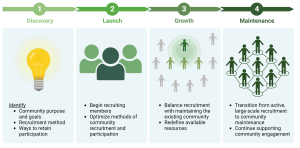Community
CVMBS is one of the many colleges in CSU that hosts a wide variety of research activities. Encouraging laboratories to adopt more sustainable research practices will be difficult on an individual basis since research groups span at least three different campuses and a multitude of buildings. However, building a community around sustainable research creates an accessible network to coordinate a reduction in resource consumption and waste production. Consequently, a sustainable research community enables CVMBS to achieve its goal of improving the planet’s health and of CSU to mitigate the climate crisis1.
Community building2

Community building occurs in four general phases: discovery, launch, growth, and maintenance.3 While these four phases are not necessarily set in stone, this resource guide serves as: (1) a summary of phase one, primarily the purpose and goals of the community, and (2) a reference for interested research labs to identify how they can adopt more sustainable practices to perform their research.
This resource guide is just one aspect of building community around sustainability in research laboratories at CSU. In addition to this guide, there are several other initiatives and actions under the umbrella of the CSU Green Labs program. The CSU Campus Energy Coordinator, Stacey Baumgarn, and the Research Safety Culture Program Coordinator, Anthony Appleton, have partnered to facilitate this program at the intersection of Sustainability and Research Safety.
In combination with other CSU Green Labs initiatives, this resource guide will specifically contribute to increasing community awareness and education surrounding sustainability in the laboratory environment. However, to increase individual and laboratory engagement with this topic and build community within CVMBS at CSU, we can use a number of other approaches. Some examples of approaches that are currently being explored are the use of a Green Lab Commitment Form, dissemination of a Green Lab Checklist, and community engagement at the annual CVMBS Research Day. A Commitment Form offers a concrete way for laboratory groups to affirm their commitment to sustainability to each other and to the greater CSU community. A Green Labs Checklist is an effective way to break down all the detailed information in the guide into simple, accessible steps that can be easily understood, with the option of referring to the full resource guide for more in-depth information. These documents can be shared by community representatives at a booth during the CVMBS Research Day to increase awareness of sustainable research within CVMBS. To generate excitement and incentivize the community, we can also introduce a Green Pipette award, to parallel the Golden Pipette award, as a part of CVMBS Research Day.
Increasing sustainability in research laboratories at CSU can also be an opportunity to engage with the greater community outside of the university. The information in this guide is applicable to other laboratories, whether they do academic, government, or industry research. Furthermore, this guide and the other Green Labs actions at CSU show the outside community that CSU is committed to combatting the climate crisis through decreasing emissions and environmental impacts.
Resources for Download:
Authors: Laura Bashor and Elena Lian
References:
- About the College. (2022). Colorado State University – College of Veterinary Medicine and Biomedical Sciences. Retrieved November 3, 2022 from https://vetmedbiosci.colostate.edu/about/
- Image created in BioRender.com
- Magwaza P. (2022). The Stages of Community Growth: What to Do and Expect at Each Phase. Commsor. https://www.commsor.com/post/stages-of-community-growth
